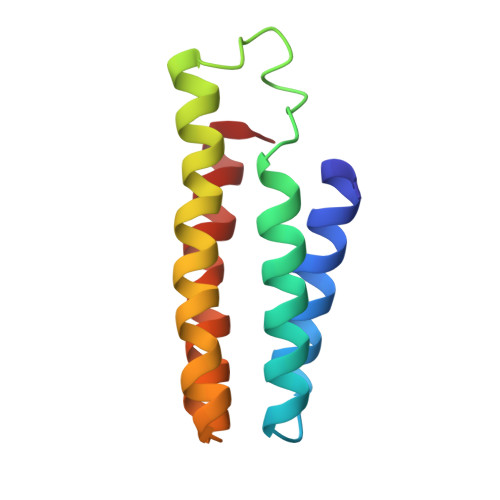Determining the Structural and Energetic Basis of Allostery in a De Novo Designed Metalloprotein Assembly.
Churchfield, L.A., Alberstein, R.G., Williamson, L.M., Tezcan, F.A.(2018) J Am Chem Soc 140: 10043-10053
- PubMed: 29996654
- DOI: https://doi.org/10.1021/jacs.8b05812
- Primary Citation of Related Structures:
6DHY, 6DHZ - PubMed Abstract:
Despite significant progress in protein design, the construction of protein assemblies that display complex functions (e.g., catalysis or allostery) remains a significant challenge. We recently reported the de novo construction of an allosteric supramolecular protein assembly (Zn- C38/C81/C96 R1 4 ) in which the dissociation and binding of Zn II ions were coupled over a distance of 15 Å to the selective hydrolytic breakage and formation of a single disulfide bond. Zn- C38/C81/C96 R1 4 was constructed by Zn II -templated assembly of a monomeric protein (R1, a derivative of cytochrome cb 562 ) into a tetramer, followed by progressive incorporation of noncovalent and disulfide bonding interactions into the protein-protein interfaces to create a strained quaternary architecture. The interfacial strain thus built allowed mechanical coupling between the binding/dissociation of Zn II and formation/hydrolysis of a single disulfide bond (C38-C38) out of a possible six. While the earlier study provided structural evidence for the two end-states of allosteric coupling, the energetic basis for allosteric coupling and the minimal structural requirements for building this allosteric system were not understood. Toward this end, we have characterized the structures and Zn-binding properties of two related protein constructs ( C38/C96 R1 and C38 R1) which also possess C38-C38 disulfide bonds. In addition, we have carried out extensive molecular dynamics simulations of C38/C81/C96 R1 4 to understand the energetic basis for the selective cleavage of the C38-C38 disulfide bond upon Zn II dissociation. Our analyses reveal that the local interfacial environment around the C38-C38 bond is key to its selective cleavage, but this cleavage is only possible within the context of a stable quaternary architecture which enables structural coupling between Zn II coordination and the protein-protein interfaces.
Organizational Affiliation:
Department of Chemistry and Biochemistry , University of California, San Diego , La Jolla , California 92093-0356 , United States.

















